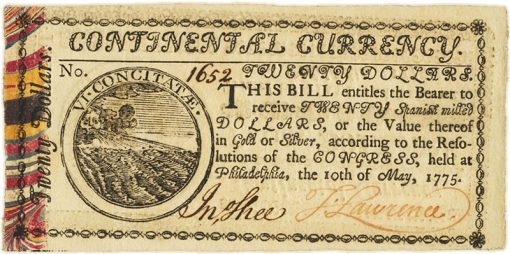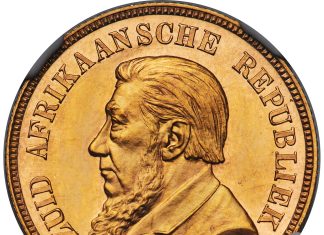Heritage Auction Galleries presents a complete collection of all 102 Friedberg Colonial numbers, considered the finest ever assembled, Aug. 11-16, at the Boston ANA World’s Fair of Money.

Heritage Auctions will be presenting The Collection of a Patriotic American, a complete grouping of all 102 Friedberg numbers associated with Continental Currency; it is believed to be the finest collection of its type ever assembled.
The collection represents more than a quarter of a century of dedicated research by one man with a passion for American history, collecting the finest examples that could be acquired. Perhaps even more importantly, the notes were selected for their eye appeal, and in the few instances where technical grade is lacking, the notes are likely finest looking, rather than finest known.
The collection does include a large number of finest known examples as well as important counterfeits, the only known Raised Denomination Continental and rarely seen counterfeit detector sheets.
The collection also includes 71 additional related items, including:
- the finest $20 marbled edge bill and the extremely rare marbled edge counterfeit detector;
- eight extra Fugio bills representing the different plate positions;
- 21 different contemporary counterfeits;
- nine sheets of Continental Currency, including a very rare sheet of Fugio bills; and
- nine counterfeit detector sheets.
Among the 71 items are 23 pieces issued by cities and states payable in Continental Currency: four notes from Albany dated 1776 and 19 typeset certificates from Georgia dated June and September 1777.
The superb May 10, 1775 marbled edge bill is truly the highlight of the collection. Unique among Continental Currency in size and shape, it is the finest known specimen of the only Continental Currency bill printed on marbled paper procured by Benjamin Franklin. Complementing this bill is its extremely rare counterfeit detector, the finer of only two extant, the other held by Colonial Williamsburg’s museum.
The full sheet of 24 Fugio bills of Franklin’s design, comprising six bills of each of the four denominations from $1/6 to $2/3, is the finest of three in existence. The overall quality of the collection is superb and contains numerous choice uncirculated and finest known specimens.
Continental Currency is inextricably linked with the history of the United States from its inception. J.W. Schuckers stated in his 1874 book A Brief Account of the Finances and Paper Money of the Revolutionary War:
"In the modern mode of making war, money is not less essential than valour in the field or wisdom in the cabinet. The deepest purse decides the fate of nations as often as the longest sword."
Accordingly, the Continental Congress authorized the first issue of Continental Currency on May 10, 1775. The bills were to be redeemed via taxes levied on the individual 13 colonies using a quota method. Congress authorized 11 different emissions, the last being January 14, 1779, resulting in the issuance of a total of $241,552,780 of Continental Currency with denominations ranging from $1/6 to $80.
The British attempted to weaken the public trust in Continental Currency with propaganda and penalties of their own. In order to devalue and destabilize the currency of the Colonies, they also engaged in economic warfare by means of extensive counterfeiting.
Kenneth Scott’s Counterfeiting in Colonial America includes a quote from Benjamin Franklin concerning the British-sponsored counterfeits:
"Paper money was in those times our universal currency. But, it being the instrument with which we combated our enemies, they resolved to deprive us of its use by depreciating it; and the most effectual means they could contrive was to counterfeit it.
The artists they employed performed so well, that immense quantities of these counterfeits, which issued from the British government in New York, were circulated among the inhabitants of all the States, before the fraud was detected.
This operated considerably in depreciating the whole mass, first, by the vast additional quantity, and next by the uncertainty in distinguishing the true from the false; and the depreciation was a loss to all and the ruin of many."
These circulating contemporary counterfeits are typically collected alongside the genuine examples and, in some cases, are rarer than the genuine bills.
Among the solutions utilized to counter the circulation of counterfeits was the distribution of counterfeit detector sheets printed on blue paper. These unsigned sheets provided a means of comparison in an attempt to determine authenticity. Other methods of deterring counterfeiting focused on making the bills difficult to replicate.
Continental bills were printed on paper containing mica flakes and blue fibers or, in the single instance of the May 10, 1775 $20 bill, marbled paper. Special type fonts, border designs, emblems, mottoes, and complex vignettes were used. Also, slight alterations in the alignment of text, variations in capitalization and italicization, as well as two-color printing, were employed in the constant battle against counterfeiting. The most fascinating counterfeit deterrent was the usage of Benjamin Franklin’s nature prints.
Included among the notable signers of Continental Currency were members of the Continental Congress and signers of the Declaration of Independence, the Articles of Confederation, and the United States Constitution.
While initially trading at par, Continental bills depreciated substantially during the Revolutionary War, eventually leading to the phrase "not worth a Continental" and causing a resistance to their usage and acceptance. As George Washington reportedly stated, "A wagonload of currency will hardly purchase a wagonload of provisions."
In the fifth edition of The Early Paper Money of America, Eric Newman wrote: "The loss of holders of currency, whether in the course of its collapse or at the conclusion of hostilities, was said by Benjamin Franklin and others to be justified as being a tax on the entire citizenry to pay for the War."
It can be argued that Continental Currency is the money that bought America’s freedom.
About Heritage Auctions
Heritage Auctions, headed by Steve Ivy, Jim Halperin and Greg Rohan, is the world’s third largest auction house, with annual sales more than $600 million, and 500,000+ registered online bidder members. For more information about Heritage Auctions, and to join and gain access to a complete record of prices realized, along with full-color, enlargeable photos of each lot, please visit HA.com.





